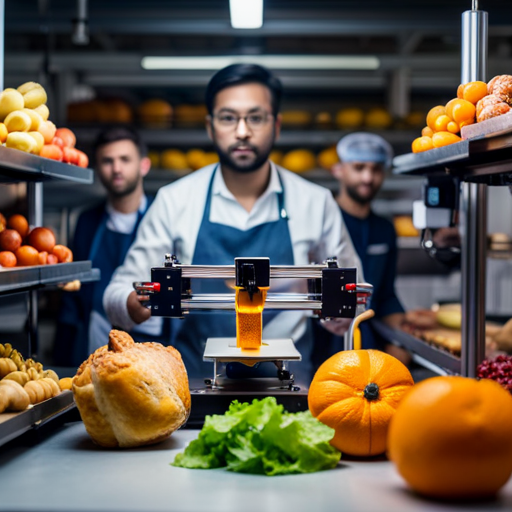In the symphony of technological innovation, the crescendo of 3D printing has reached the realm of food production.
As consumer demand for personalized nutrition and sustainable solutions grows, the global market for food 3D printing is witnessing a harmonious convergence of technological advancements and culinary creativity.
This article delves into the analysis and trends shaping this transformative landscape, exploring the opportunities and challenges that lie ahead.
Technological Advancements in Food 3D Printing
Analyzing the technological advancements in food 3D printing reveals significant progress in precision, speed, and material diversity.
The innovation in food 3D printing has ushered in a new era of culinary creativity and gastronomic possibilities. Advancements in this technology have significantly enhanced precision, allowing for intricate designs and details to be replicated with astonishing accuracy. This precision has expanded the gastronomic possibilities, enabling chefs to create visually stunning and complex dishes that were previously unattainable through traditional methods.
Furthermore, the speed of food 3D printing has seen remarkable improvements, with the capability to produce intricate food items in a fraction of the time it would take using conventional techniques. This not only increases efficiency in the kitchen but also opens doors for large-scale food production using 3D printing technology.
Material diversity is another area where substantial progress has been made. The range of ingredients that can be used in food 3D printing has expanded, allowing for the creation of a wider variety of foods, including those with unique textures and flavor combinations.
These advancements have revolutionized the culinary landscape, offering chefs and food manufacturers unparalleled opportunities for innovation and creativity.
Consumer Demand and Adoption
The increasing consumer demand for food 3D printing technology is driving widespread adoption across various culinary and food manufacturing sectors. As consumer preferences evolve towards personalized and sustainable food options, the market for food 3D printing is experiencing significant growth. Consumers are increasingly seeking healthier, customized, and visually appealing food products, which align with their dietary needs and lifestyle choices. This shift in consumer behavior is pushing food manufacturers and culinary professionals to explore innovative ways to meet these demands, leading to the integration of 3D printing technology in the food industry.
| Consumer Preferences | Market Growth |
|---|---|
| Personalized food items | Increased investment |
| Healthier food options | Expansion of product lines |
| Sustainable food choices | Enhanced customization |
| Visually appealing | Adoption across sectors |
The table above highlights the correlation between consumer preferences and the resulting market growth in the food 3D printing sector. This intersection is propelling the widespread adoption of 3D printing technology in the culinary and food manufacturing domains.
Personalized Nutrition and Dietary Customization
Amid the evolving landscape of culinary innovation, personalized nutrition and dietary customization have emerged as significant focal points in the realm of food 3D printing technology. This innovative approach allows for the creation of tailored food items to meet individualized nutritional needs and preferences. Personalized diets, tailored to an individual’s specific health requirements and dietary restrictions, are now achievable through the precision and flexibility offered by 3D food printing. This technology enables the customization of food based on factors such as nutrient levels, allergens, and taste preferences, thereby revolutionizing the way people consume and interact with food.
The health benefits of personalized nutrition are substantial, with the potential to address various health concerns such as obesity, diabetes, and cardiovascular diseases. By providing precise control over the nutritional content of food, 3D printing facilitates the creation of meals that align with an individual’s health objectives. Furthermore, this level of customization can enhance the overall dining experience, promoting adherence to healthy eating habits.
As the demand for personalized nutrition continues to grow, food 3D printing is poised to play a pivotal role in shaping the future of dietary customization and nutritional wellness.
Sustainable Food Production and Environmental Impact
As the global market for food 3D printing continues to expand, the focus on sustainable food production and its environmental impact has become increasingly integral to the industry’s development.
Sustainable agriculture practices have gained prominence, emphasizing the need for environmentally friendly and resource-efficient food production methods. This shift towards sustainability aims to minimize the environmental footprint of food 3D printing and traditional food production processes.
Waste reduction in food production has also emerged as a critical concern, prompting the exploration of innovative techniques to minimize food wastage throughout the 3D printing process and supply chain.
Moreover, the adoption of sustainable practices not only addresses environmental concerns but also contributes to the ethical and social aspects of food production, aligning with consumer expectations for responsible and eco-conscious manufacturing processes.
The industry is actively pursuing solutions to optimize resource utilization, reduce waste, and ensure long-term ecological viability, reflecting a commitment to sustainable food production and environmental stewardship.
Opportunities and Challenges in the Global Market
In the expanding global market for food 3D printing, various opportunities and challenges are arising, particularly in the context of sustainable resource utilization and waste reduction. The table below highlights key aspects related to market opportunities and challenges in food 3D printing.
| Opportunities | Challenges |
|---|---|
| Market competition | Regulatory hurdles |
| Supply chain | Quality control |
Market competition in the food 3D printing industry is intensifying as more companies enter the market, driving innovation and pushing the boundaries of what is possible. However, this also presents challenges in terms of differentiating products and ensuring compliance with evolving regulations. Moreover, optimizing the supply chain for food 3D printing is an opportunity to streamline production and reduce waste, yet it requires careful management to ensure consistent quality and safety standards. Regulatory hurdles related to food safety and additive materials must be navigated effectively. Quality control is also paramount, as maintaining the taste, texture, and nutritional value of 3D printed foods while ensuring safety and compliance is a significant challenge. Balancing these opportunities and challenges will be crucial for the sustainable growth of the food 3D printing market.
Frequently Asked Questions
Can 3D Food Printing Technology Be Used to Create Food That Meets Specific Dietary Restrictions or Allergy Requirements?
Customized nutrition through 3D food printing technology enables the creation of allergen-free and dietary restriction-specific food. This innovative approach utilizes food technology to cater to individual needs, providing a solution for personalized dietary requirements.
How Does 3D Food Printing Technology Address Food Waste and Promote Sustainable Food Production?
Addressing food waste and promoting sustainable food production, 3D food printing technology enhances efficiency and reduces wastage through precise ingredient usage. It also contributes to food preservation, aligning with sustainability goals and minimizing environmental impact.
What Are the Potential Ethical Considerations and Implications of Personalized Nutrition and Dietary Customization Through 3D Food Printing?
The potential ethical implications of personalized nutrition and dietary customization through 3D food printing are significant, especially regarding privacy, equity, and cultural sensitivity. Balancing individual needs with broader societal impacts and ensuring access for all poses complex challenges.
Are There Any Regulatory or Safety Concerns Associated With the Use of 3D Food Printing in the Global Market?
Regulatory concerns surrounding 3D food printing in the global market center on ensuring adherence to food safety standards and labeling requirements. Safety considerations involve potential allergen cross-contamination, equipment sanitation, and the use of food-grade materials.
How Does 3D Food Printing Technology Impact Traditional Culinary Practices and Food Culture in Different Regions Around the World?
3D food printing technology impacts traditional culinary practices and food culture globally, driving culinary evolution, cultural adaptation, and technological influence. It reshapes food presentation, customization, and production methods, challenging conventional cooking techniques and fostering innovation.
Conclusion
In conclusion, the global market for food 3D printing is experiencing significant technological advancements and growing consumer demand. The industry is moving towards personalized nutrition and dietary customization, while also addressing sustainable food production and environmental impact.
There are opportunities for growth, but also challenges to overcome. As the saying goes, ‘necessity is the mother of invention,’ and the food 3D printing industry will continue to evolve to meet the needs of consumers and the planet.


